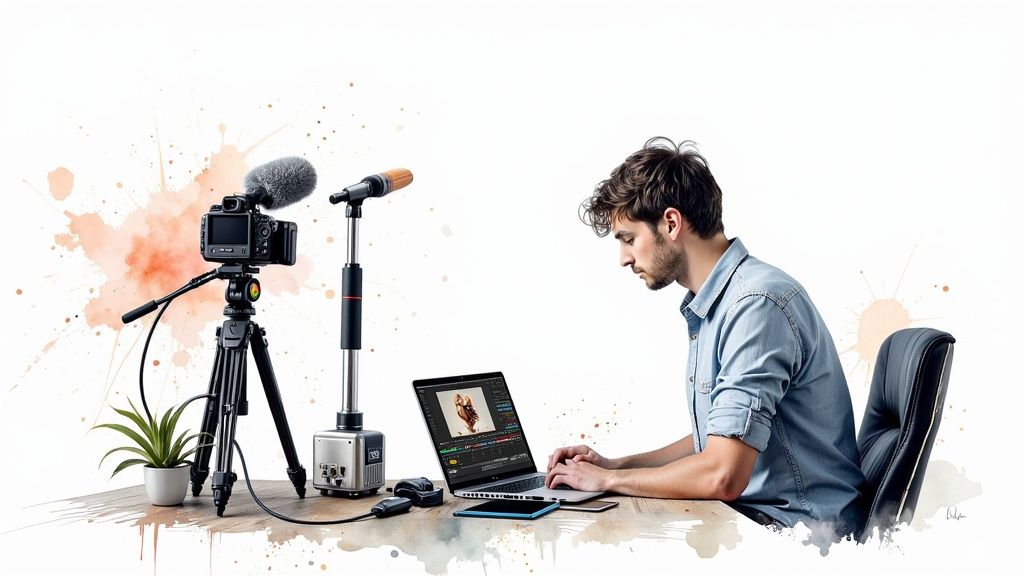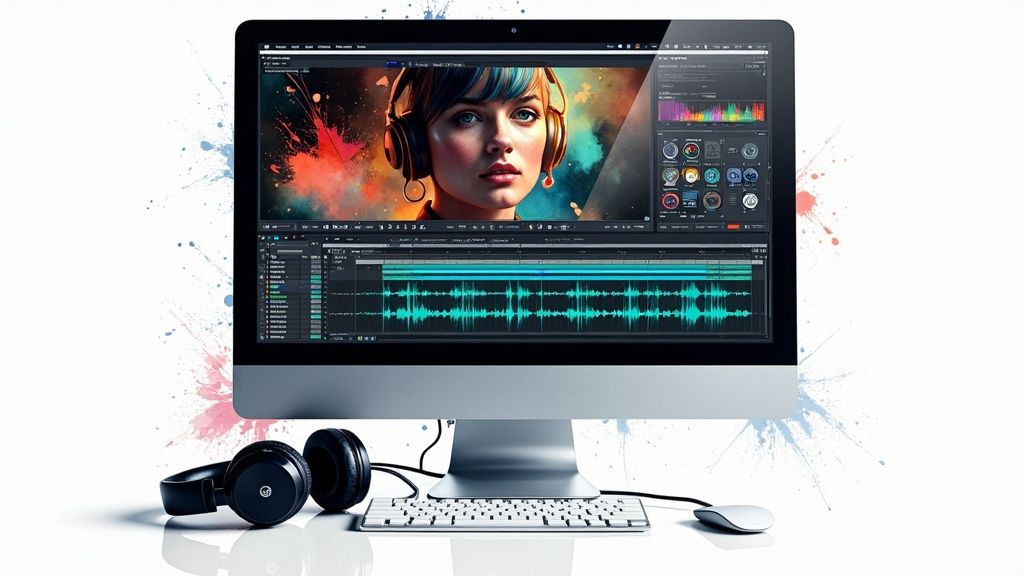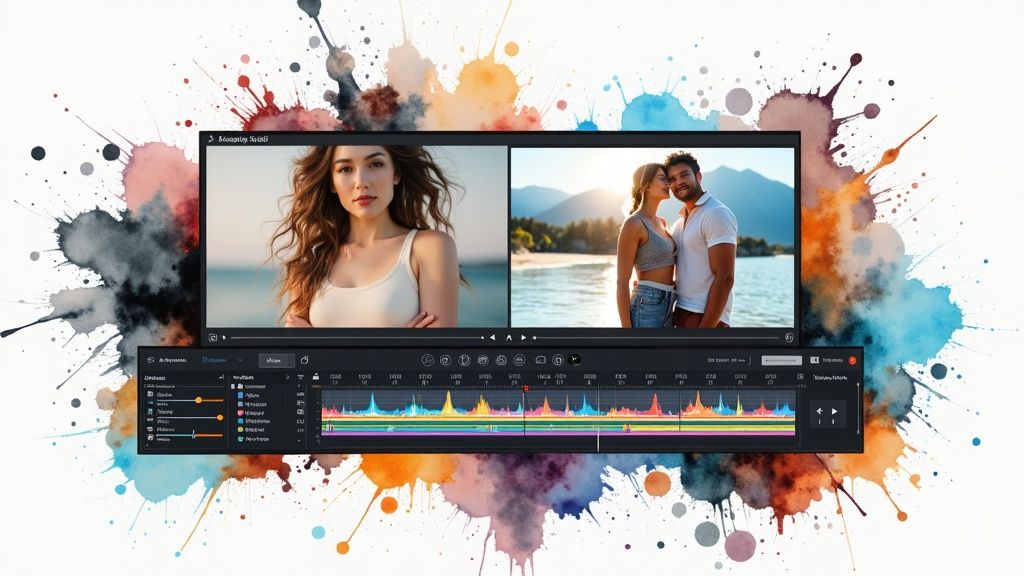Understanding the Power of Professional Voice Overs

A professional voice over takes your video content to the next level by turning visuals into compelling stories that captivate viewers and improve understanding. But what makes voice overs so effective at engaging audiences? Let's explore the science behind impactful narration and see how it can boost your video's performance.
Why Voice Overs Matter in the Digital Age
Consider your own media habits - how often do you listen to audio while doing other tasks like commuting, exercising, or working? You're not alone. According to Nielsen, 79% of audio consumption happens during other activities. This means that a well-crafted voice over keeps your video engaging even when viewers aren't fully focused on the screen. For instance, someone cooking dinner can still follow along with your product demo through clear narration.
Quality voice overs also make complex ideas easier to grasp. A skilled narrator can break down difficult concepts, emphasize key points, and add emotional depth that complements your visuals. The results speak for themselves - many content creators report that adding professional voice overs doubles their video completion rates. Higher completion rates lead to more views, better brand recognition, and stronger audience connections.
The Psychology of Effective Narration
The right voice has a powerful psychological impact on how we process information. A clear, engaging narrator builds trust and makes your message more convincing. Think about how documentaries use soothing voices to draw you into the story, or how energetic commercial voiceovers get you excited about products.
But it takes more than just a pleasant voice - delivery, pacing, and tone are crucial. Even clear speech becomes boring if it's monotone. The best narrators vary their energy and emphasis to keep viewers hooked from start to finish. That's why practicing your voice control is essential for creating engaging content. For more tips, check out: How to do a video voice over: A comprehensive guide for 2024.
The Growing Voice Over Industry
As demand for quality video content rises, the voice over industry continues to expand. The global market has reached $4.4 billion, with online content creation making up a major portion. This shows how much businesses value professional narration for connecting with audiences. Animated videos, which often rely on voice overs, account for about 33% of video ads worldwide.
This growth trend shows no signs of slowing. The ongoing rise of online video and audio content means skilled voice actors are increasingly in demand. Whether you want to improve your own content or explore voice acting opportunities, learning voice over techniques is becoming an essential skill for content creators.
The best strategy for rewriting is to identify the key points and structure them naturally while maintaining a conversational yet professional tone.
Creating Your Perfect Recording Environment
A high-quality voice over starts with the right recording space. You don't need expensive gear to get started - what matters most is setting up your environment thoughtfully to capture clean audio. Let's explore how to create an effective recording space that will help you produce professional-quality voice overs for your videos.

Acoustic Treatment on a Budget
The key to good audio is controlling sound reflections in your recording space. When sound bounces off walls and surfaces, it creates echoes and reverb that can make your voice recordings unclear. While professional studios invest in acoustic panels, you can achieve similar results with everyday items. For instance, hanging thick blankets on walls helps absorb sound reflections. Bookshelves filled with books work well as natural sound diffusers, preventing audio from bouncing straight back to your mic. Even thoughtfully arranging furniture can significantly improve your room's acoustics.
Microphone Selection and Placement
The way you position your microphone matters more than having the most expensive model. For those just starting out, USB microphones offer good quality at an accessible price point. No matter which mic you choose, take time to test different positions and angles to find what works best for your voice. A simple pop filter screen can make a big difference by reducing harsh sounds from consonants like "p" and "b". This small investment helps create cleaner, more polished recordings.
Minimizing Background Noise
Even small background sounds like computer fans or street noise can affect your audio quality. Start by identifying and eliminating as many noise sources as you can. Close windows and doors to block outside sounds and turn off any unnecessary electronics to reduce electrical hum. Consider recording during quieter times - early morning or late evening often work well since ambient noise levels are lower. When you carefully control your recording environment this way, you create the foundation for clear, engaging voice overs that will enhance your video content. Taking time to get these details right is what helps your recordings stand out.
Writing Scripts That Connect With Your Audience
A well-crafted script forms the backbone of any quality voiceover video. Rather than simply listing facts and information, your script needs to tell a compelling story that draws viewers in and keeps them engaged. Just as proper audio equipment helps capture clean sound, a thoughtfully written script elevates your entire production.
Structuring Your Script for Maximum Impact
Think of your script as the roadmap for your voiceover video's journey. Before hitting record, map out your key messages and organize them into clear, logical sections. This helps viewers follow along easily and retain the information you're sharing. Each section should flow naturally into the next, building a coherent narrative. For example, you might start with a problem, explain the solution, and end with a clear call to action. Just as an architect needs detailed plans before construction begins, your script provides the essential framework for a polished final product.
Writing for the Ear, Not the Eye
Writing for voiceover requires a different approach than writing for readers. While you want to be clear and concise, you also need to consider how your words will sound when spoken aloud. Keep sentences short and simple, avoiding technical jargon that might confuse listeners. Imagine having a conversation with a friend - this helps maintain a natural, engaging tone. Pay attention to your voice's rhythm and pitch variations to emphasize key points and maintain listener interest throughout the video.
Adapting Your Style for Different Content Types
Your script's tone and style should match your video's purpose and target audience. A product demo might focus on benefits and features with an upbeat energy, while an educational video calls for a more measured, informative approach. The key is understanding who you're speaking to and what they need to learn. For instance, technical audiences might appreciate more detailed explanations, while general audiences need simpler breakdowns of complex topics. You might be interested in: Top Video Editing Software for Social Media in 2024.
Common Script Issues and How to Avoid Them
Many first-time script writers make common mistakes that can weaken their videos. Long, winding sentences, excessive technical terms, and abrupt topic changes can leave viewers confused and disengaged. Reading your script out loud helps identify awkward phrasing and flow issues before recording. Getting feedback from others provides valuable perspective on clarity and impact. Just as you'd remove background noise to improve audio quality, polishing your script removes barriers to understanding. Focus on clear, conversational language that guides viewers smoothly through your message. Taking time to refine these elements results in a more professional, engaging final video that truly connects with your audience.
Mastering Professional Recording Techniques

Creating great voice overs requires more than just reading words off a page - it's about mastering specific techniques that make your audio engaging and impactful. With your script and recording space ready, let's explore the key methods that will help you produce professional-quality voice overs for your videos.
Warming Up Your Vocal Cords
Just as athletes stretch before exercising, voice actors need to prepare their vocal cords before recording. A proper warm-up prevents strain and helps maintain consistent quality during long sessions. Start with simple exercises like humming up and down musical scales to loosen your vocal cords. Add some tongue twisters and deep breathing exercises to improve clarity and stamina. Even 5-10 minutes of warm-up can make a noticeable difference in your recording quality.
Mastering Breath Control and Pacing
Good breath control forms the foundation of smooth, professional voice overs. When you run out of breath mid-sentence, it breaks the flow and sounds amateur. Practice breathing from your diaphragm to control airflow better. Pay attention to your pacing too - vary your speed to keep listeners engaged. Slow down slightly for important points and pick up the pace during exciting sections. Finding the right rhythm takes practice but makes your voice overs much more captivating.
Developing Your Unique Voice Over Style
While proper technique matters, adding your own personality helps your voice overs stand out. Try different tones and inflections to see what fits your content best. For example, use a friendly, conversational approach for explaining concepts, but switch to a more authoritative tone for corporate videos. Think about the emotional response you want from your audience and adjust your delivery accordingly. This helps you develop a distinctive style that sets your work apart.
Common Recording Mistakes and How to Avoid Them
Even experienced voice actors make mistakes, but knowing what to watch for helps you avoid common issues. One frequent problem is inconsistent volume throughout the recording. Fix this by keeping a steady distance from your microphone and monitoring audio levels as you record. Another mistake is rushing through the script without proper pauses between sentences. Taking deliberate breaks adds clarity and impact. Also watch out for "uptalk" - raising your voice at the end of sentences as if asking a question. This can make you sound uncertain. Being aware of these pitfalls helps you create polished, engaging voice overs that enhance your videos.
Seamless Video and Voice Over Integration

Once you've recorded your professional voice over and written your script, it's time to bring these elements together in your video. This process requires careful attention to detail - from perfectly timed synchronization to balanced audio levels. Getting these technical aspects right is key to creating a polished final product that keeps viewers engaged.
Cleaning Up Your Audio Track
Start by ensuring your voice over recording is crystal clear and free of distractions. Even minor background noises like hums or clicks can pull viewers out of the experience. Most editing software includes noise reduction features to help eliminate unwanted sounds. Pay special attention to breath sounds - they should sound natural without being obvious. Taking time for this initial cleanup sets a strong foundation for the rest of your audio work.
Achieving Perfect Synchronization
Matching your voice over precisely to your video is essential for keeping viewers engaged. When narration doesn't align with what's on screen, it creates a jarring disconnect. Think about watching a product demo where the narrator describes features that don't match what you're seeing - it immediately breaks the viewer's focus. Use your editing software's tools to line up audio with key visual moments, like when specific objects appear or actions occur. This attention to timing creates a smooth, natural flow.
Balancing Voice Over With Music and Sound Effects
While background music and effects can add atmosphere to your video, they should enhance rather than compete with your voice over. Find the sweet spot where all audio elements work together harmoniously. During narration, lower music volumes so the voice stays clear and easy to understand. Add sound effects thoughtfully to highlight important moments without overshadowing the narration. This balanced approach keeps viewers immersed in your story. Learn more in our article about easy video editing for YouTube Shorts.
Smooth Transitions For a Professional Finish
The way you transition between different sections of your video matters just as much as the content itself. Rather than abrupt changes between clips or audio elements, use gentle fades to create seamless flow. For example, slowly fade down background music as voice over begins, then gradually bring it back up after the narration ends. Consistently smooth transitions throughout your video show attention to detail and add a professional polish to your work.
Working With Popular Editing Software
Getting familiar with your editing software's audio tools will make your workflow much more efficient. While basic volume adjustments are standard features, learning advanced capabilities like keyframing and audio effects can significantly improve your results. For instance, use keyframes to precisely control music volume during voice overs or apply equalizers to enhance vocal clarity. By mastering these features, you'll be able to create videos that sound as professional as they look while clearly delivering your message to viewers.
Platform-Specific Optimization Strategies
Creating engaging video content with voice over requires understanding how different platforms consume and showcase content. Each platform has its own technical specifications, viewer behaviors, and best practices. Let's explore proven strategies for optimizing your voice over videos across various channels.
Social Media: Short, Snappy, and Engaging
Social media demands quick, compelling content that grabs attention in seconds. As users rapidly scroll through their feeds, your voice over needs an immediate hook. A focused 30-60 second script delivered with energy works well on platforms like TikTok. Consider incorporating popular audio trends or background music - just be sure to balance levels so your voice over remains clear and prominent. Even with brief videos, careful preparation ensures your message connects with viewers.
Professional Presentations: Clear, Concise, and Authoritative
Professional settings call for a more measured approach focused on clarity and expertise. Your voice over should guide viewers through information methodically while building credibility. For example, when presenting research or analysis, use a confident, steady tone that helps viewers absorb complex details. Keep visuals simple and purposeful to support rather than distract from your narration. This creates a polished presentation that reinforces your message's authority.
Marketing Campaigns: Targeted Messaging and Emotional Connection
Marketing videos require voice overs tailored to specific audience preferences. Younger viewers often respond to upbeat, casual delivery while professional audiences prefer more formal, informative tones. A product demo targeting tech enthusiasts might use quick, feature-focused narration. Brand storytelling usually needs warmer, more conversational voicing to build trust. Understanding your viewers helps you choose the right vocal approach.
Animated vs. Live-Action: Tailoring Your Voice Over Approach
With animated content making up 33% of global video ads, optimizing voice overs for animation is crucial. Animation allows more creative freedom with character voices and personality. Live action generally needs more natural, documentary-style narration that matches the real-world visuals. Focus on finding a voice over style that enhances your specific visual content and connects with viewers.
Maintaining Consistent Quality Across Platforms
High-quality audio is essential regardless of platform. Record in a quiet space using good equipment to minimize background noise and ensure clarity. Pay attention to how voice over mixes with music and effects - they should support rather than overshadow your narration. Consistent audio quality keeps viewers engaged and signals professionalism across all distribution channels.
Aeon provides publishers with tools to easily create polished videos with voice over optimized for any platform. Our AI-powered platform helps streamline production while maintaining quality. Learn more at https://www.project-aeon.com.